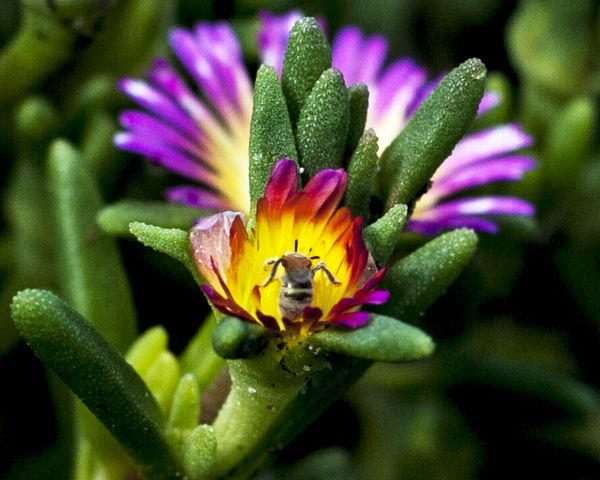One More Time (Damn The Torpedoes)
Apr 23, 2021 10:00:10 #
Often folks post questions about how can they get "better images", "sharper photos", etc. Along with proper photo technique the majority of answers seem to be "Great Glass." I agree ... up to a point.
In days of yore (film camera days) shooters often did tests to see which film could produce images that were "crisp and snappy" (sounds like a potato chip, don't it?) and provided the best Detail with good Contrast. Low RMS films generally won out. Today, our "Film" is the sensor inside the digital camera and, just like photo film, they vary hugely.
I addressed this once before [https://www.uglyhedgehog.com/t-501318-1.html] and [https://www.uglyhedgehog.com/t-499318-1.html] and have since then alluded back to those posts in answer to questions on "Which camera will produce the sharpest images." This is an update using cameras from the same manufacturer (Nikon), the same lens on all cameras (Nikkor 85mm f/1.8 AF-D], and the same settings and conditions throughout. The cameras had sensors of 12MP, 16MP, 24MP, 36MP (D800E and D810), and 46MP.
Below are resulting images. First is the set-up as seen from the camera position. Then come the individual target images.
None of the images have been "adjusted" or "tweeked" in any way. I see the Exposure "drifts" a bit from camera to camera (the D810 was just recently bought and I need to do more testing with it). Sharpness, Saturation, Tint, all set to the same values. Other conditions of the test same as first time around with exception of my newer lens just released by Nikon in 2019. I used ISO 200 as that is the lowest native ISO available for the D700. Yes, I shot other/lower ISOs on the other cameras and, yes, IQ does improve somewhat.
This kind of stuff isn't for everybody. Not all of us on this forum are Nerds. But for those who are, I thought you might find this interesting.
In days of yore (film camera days) shooters often did tests to see which film could produce images that were "crisp and snappy" (sounds like a potato chip, don't it?) and provided the best Detail with good Contrast. Low RMS films generally won out. Today, our "Film" is the sensor inside the digital camera and, just like photo film, they vary hugely.
I addressed this once before [https://www.uglyhedgehog.com/t-501318-1.html] and [https://www.uglyhedgehog.com/t-499318-1.html] and have since then alluded back to those posts in answer to questions on "Which camera will produce the sharpest images." This is an update using cameras from the same manufacturer (Nikon), the same lens on all cameras (Nikkor 85mm f/1.8 AF-D], and the same settings and conditions throughout. The cameras had sensors of 12MP, 16MP, 24MP, 36MP (D800E and D810), and 46MP.
Below are resulting images. First is the set-up as seen from the camera position. Then come the individual target images.
None of the images have been "adjusted" or "tweeked" in any way. I see the Exposure "drifts" a bit from camera to camera (the D810 was just recently bought and I need to do more testing with it). Sharpness, Saturation, Tint, all set to the same values. Other conditions of the test same as first time around with exception of my newer lens just released by Nikon in 2019. I used ISO 200 as that is the lowest native ISO available for the D700. Yes, I shot other/lower ISOs on the other cameras and, yes, IQ does improve somewhat.
This kind of stuff isn't for everybody. Not all of us on this forum are Nerds. But for those who are, I thought you might find this interesting.
The Scene
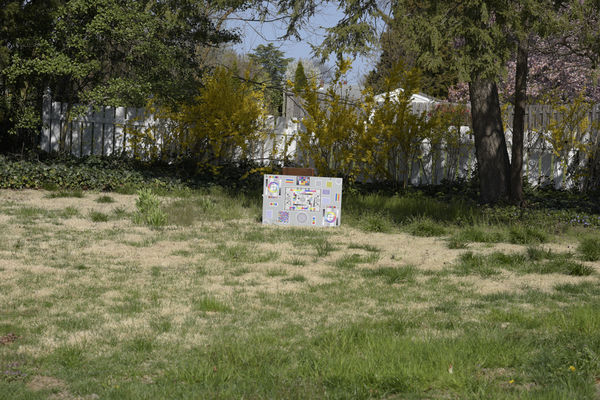
(Download)
D700 at Base ISO200
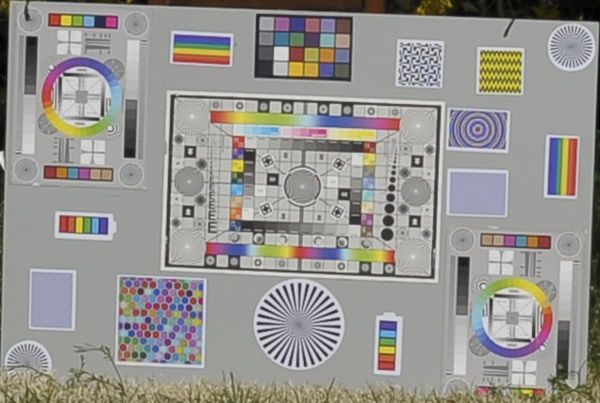
(Download)
Df at ISO200
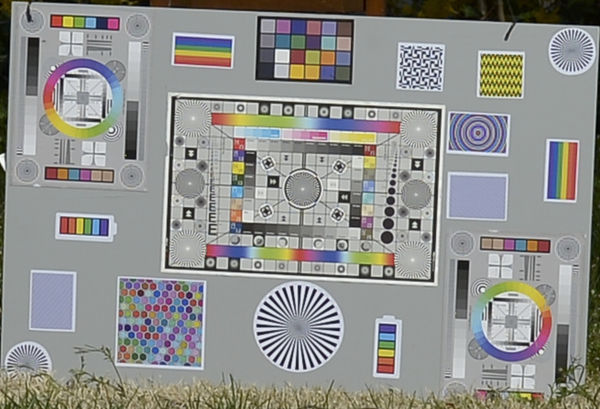
(Download)
D610 at ISO200
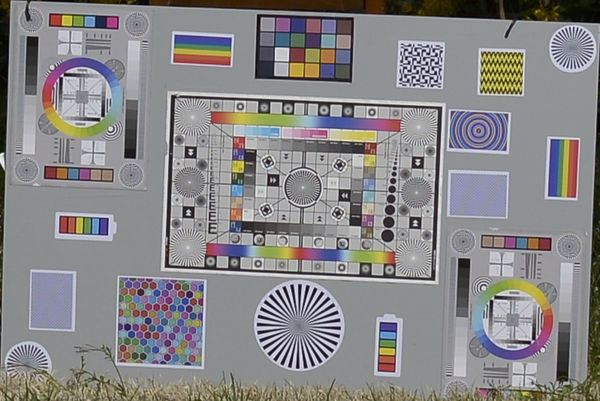
(Download)
D800E at ISO200
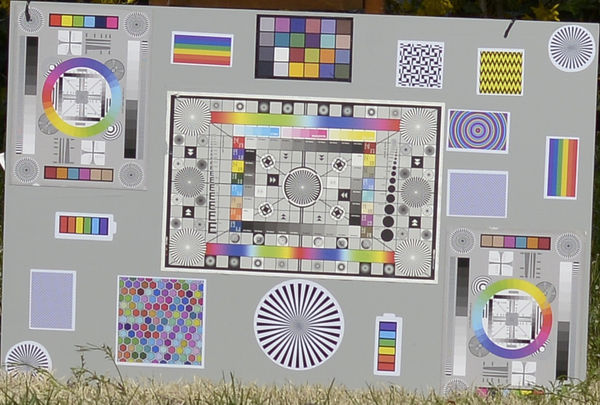
(Download)
D810 at ISO200
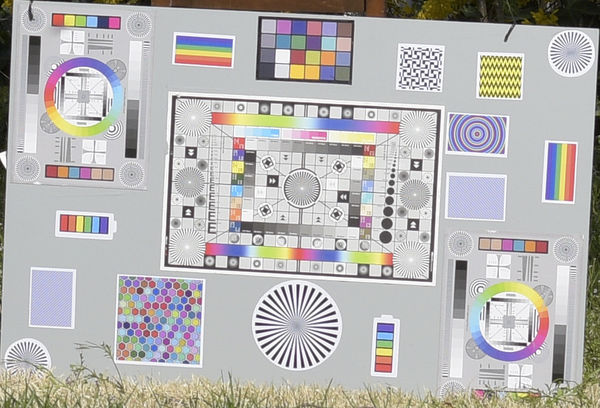
(Download)
D850 at ISO200
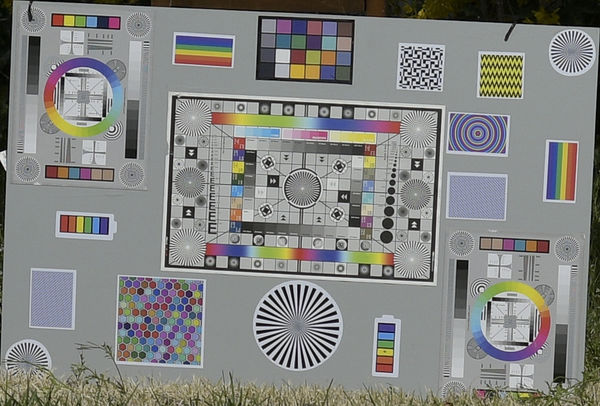
(Download)
Apr 23, 2021 10:46:37 #
Why 1100x700 ish pixels for the examples? Did you look at these full screen? Honestly, I don't think any of them are in focus. Before cropping / resizing, did they seem in focus on your monitor?
I don't see the lens reported. From the distance shot, is that trying to say you the cropped the chart from that distance? Or, did you run your test with a lens set to a position / focal length to fill the sensor? If these are to show the cropping options, you might consider Rongnongno's recent comment about cropping in post instead of getting closer. Robert Capa had some thoughts about getting closer too.
You might consider the ideas presented here: How to obtain sharp images in digital photography
I don't see the lens reported. From the distance shot, is that trying to say you the cropped the chart from that distance? Or, did you run your test with a lens set to a position / focal length to fill the sensor? If these are to show the cropping options, you might consider Rongnongno's recent comment about cropping in post instead of getting closer. Robert Capa had some thoughts about getting closer too.
You might consider the ideas presented here: How to obtain sharp images in digital photography
Apr 23, 2021 11:33:30 #
cameraf4 wrote:
.../...
There is indeed a sharpness issue.
To solve it, just use live view and manual focus after magnifying on the target.
This is a good effort to show something of interest for those who have one of the cameras used, the lack of focus destroyed it.
Too many so-called tests are made in a lab do they do not reflect the reality of every day use.
Try one more time, please.
When you do...
Use the same lens as it is important when comparing sensors ability to resolve lines.
Solve the focus issue
Do not crop and post
Post as PNG 8 (small files)
Ideally post raw test files and link them to your post after uploading them somewhere else.
Good luck
I wish I could be more positive.
I understand the "Damn the torpedoes"...
 You cannot dodge them in a forum...
You cannot dodge them in a forum... 
Apr 23, 2021 11:47:47 #
Apr 23, 2021 12:21:35 #
D850 looks best to me. A big difference from the D700. I think it's a good test because it shows what auto focus will yield on those camera. That's the way most people shoot. It's not a test to see how sharp you can get the image, but how the image will appear when you just take a picture.
Apr 23, 2021 14:46:34 #
cameraf4 wrote:
Often folks post questions about how can they get ... (show quote)
I am a nerd also. My question is this. Is the lens adjusted to each camera or is it luck of the draw? In order for it to compare sensors the camera must be tuned to the lens to remove as much difference from the lens camera match. I have been playing with tuning my camera to my lenses and it is interesting. One must have patience and consistency and I run each test 3 times to ensure the correct results but it is worth the effort for my piece of mind. May not make that much difference most of the time but Nikon spent a lot of research and money on putting the adjustment features in the higher end camera's. Being a cutter of gems and a builder of engines over the years I can tell you that if I put a engine together and match the parts commonly called blueprinting of an engine and remove as much of the manufacturing tolerances to obtain as close as possible to perfect I get a higher horsepower more reliable engine. So I'm pretty sure it works the same for lenses and cameras. A matched set works better. Ok I'm off subject. Sorry. I am curious about the results when you iron out a few issues of the test.
Apr 23, 2021 14:55:08 #
Bobspez wrote:
D850 looks best to me. A big difference from the D700. I think it's a good test because it shows what auto focus will yield on those camera. That's the way most people shoot. It's not a test to see how sharp you can get the image, but how the image will appear when you just take a picture.
Thanks, Bob, but Paul and Dennis have a good point. When I did this test before, I used my "trusty" Nikkor 50mm f/1.4, a lens long praised for its sharp images. Conventional wisdom (at least on this forum) has been saying that newer lenses are "better". I, foolishly, believed that and bought the 85mm introduced in 2019 specifically to do this test. Now admittedly, my 70y/o eyes ain't what they use to be but I thought that the Focus Assist lights inside the various viewfinders would cover my butt. When I saw the results I was hugely disappointed.
Retirees have a bunch of time on our hands (especially during a pandemic) so I will "try again" but this time I'll use LiveView AND "my trusty 50mm".
I would say "Film at eleven" but most folks say "film is dead". I'll wait for another sunny, dry, windless day.
Apr 23, 2021 15:02:46 #
Drbobcameraguy wrote:
I am a nerd also. My question is this. Is the lens... (show quote)
I'm with you, Doc. Early on I did calibrate my first few DSLRs to my "most used" lenses using: [https://www.slrlounge.com/calibrate-lenses-simple-fix-blurry-images/]
I was not seeing many fruits of my labors there so, being lazy most of my life, I haven't got back to that. Probably should do it, as well as calibrate the exposure on the D810 before I go "back to the Lab". No promises, I'm even lazier now that Old age has "bit my butt".
Apr 23, 2021 15:51:23 #
Drbobcameraguy wrote:
I am a nerd also. My question is this. Is the lens... (show quote)
Exactly. Any differences in sharpness could easily be attributed to the tolerance stack up between camera and lens that weren’t calibrated together. One more variable...
Apr 23, 2021 15:52:54 #
cameraf4 wrote:
Often folks post questions about how can they get ... (show quote)
Good idea, but, to eliminate more variables, you may want to try shooting raw, using a spot meter on a grey card target, and using only live view for focusing. This removes exposure variations, focus anomalies and makes the test more informative. Also, in processing the files, reduce the image size to 12 mp, which will mean that all higher mp cameras will be downsampled to the same as the D700.
Apr 23, 2021 16:40:02 #
cameraf4 wrote:
Thanks, Bob, but Paul and Dennis have a good point... (show quote)
Looking forward to it but I would be surprised if the results turn out differently. Then the question becomes how sharp does a picture need to be? Other than the D700 I thought they were all definitely sharp enough.
I've done my own similar tests and compared my Nikon 55-300 lens on three cameras, an old full frame, a D7000 and a Nikon J1 with an autofocus adapter and a one inch sensor. Not surprisingly to me, as the sensors got smaller, the sharpness improved due to the improved equivalent focal lengths of 300mm, 450mm, and 810mm. I know that is against conventional wisdom, but that's what I found out. Once smaller than a 1" sensor though it's not possible to crop 100% so for sharpness I think the 1" sensor is the limit.
And I wouldn't be worried about old lenses. Here's a deeply cropped shot I got by accident from a couple of feet away with my Nikkor f1.4 50mm and an old D200 with the CCD sensor, handheld in sunlight. Bear in mind that the whole red and yellow flower bud was just 1/4" across, and to the naked eye the bug which was about 1/16" across by 1/8" long looked like a black gnat. I didn't even know he was in the frame.
Apr 23, 2021 21:29:41 #
Gene51 wrote:
Good idea, but, to eliminate more variables, you may want to try shooting raw, using a spot meter on a grey card target, and using only live view for focusing. This removes exposure variations, focus anomalies and makes the test more informative. Also, in processing the files, reduce the image size to 12 mp, which will mean that all higher mp cameras will be downsampled to the same as the D700.
Actually Gene, with each camera I shot both NEF (RAW) and Jpegs under Neutral Picture Control. On my VDT I saw no appreciable difference so I used the Jpegs. I Spot metered on the center of the central target but, as I said, I focused manually using Focus Assist through the viewfinder. LiveView is definitely the way to go next time.
Still a tad techno-challenged I'm afraid. May I ask how would one "downsample" to the 12MP size?
Apr 23, 2021 21:38:29 #
Bobspez wrote:
Looking forward to it but I would be surprised if ... (show quote)
Actually, I have been an advocate of older Nikkors for years. Have owned more than I can remember. But, as I said, "conventional wisdom" seems to say that given improvements in optical design, lens coatings, use of rare earth glass elements, etc., a more recently marketed Nikkor should be above reproach. I've seen articles sing the praises of the 85mm 1.4 within the past year. So, I'm chalking this fiasco up to "Operator Error". I'll try to do better next time around.
Apr 24, 2021 04:03:53 #
cameraf4 wrote:
Actually Gene, with each camera I shot both NEF (RAW) and Jpegs under Neutral Picture Control. On my VDT I saw no appreciable difference so I used the Jpegs. I Spot metered on the center of the central target but, as I said, I focused manually using Focus Assist through the viewfinder. LiveView is definitely the way to go next time.
Still a tad techno-challenged I'm afraid. May I ask how would one "downsample" to the 12MP size?
Still a tad techno-challenged I'm afraid. May I ask how would one "downsample" to the 12MP size?
Focus Assist uses the Phase Detect AF system (PDAF) to establish communication between the lens and camera, so it can produce focusing errors if a particular camera and lens is out of focus. Setting in-camera picture controls for jpegs assumes that neutral on one camera is the same as neutral on another. They may be close, but not necessarily the same. Each camera sample has a unique color response - even for raw capture. Using a target like an Xrite ColorChecker Passport, will let you create a neutral camera profile that would result in color and exposure (I think) to be virtually indistinguishable from one camera to the next. When shooting events with second and third shooters and multiple cameras, I would create color profiles for each lighting scenario for each camera. It's bit of a pain, but it worked like a charm, saving hours of post processing. Also, any change in the lighting would result in differences in color balance and exposure - radical ones - especially if overcast.
The D700 is 4256x2832 px. The D850 is 8256x5504px. You would use software to resample the D850 so that the pixel count on the longest side = 4256px. There is no magic here, other than noise and image quality often improves when downsampling a high MP camera image - but comparing images of equal size is important to your illustration.
Apr 24, 2021 07:19:10 #
Gene51 wrote:
Good idea, but, to eliminate more variables, you may want to try shooting raw, using a spot meter on a grey card target, and using only live view for focusing. This removes exposure variations, focus anomalies and makes the test more informative. Also, in processing the files, reduce the image size to 12 mp, which will mean that all higher mp cameras will be downsampled to the same as the D700.
While I agree about the exposure, wouldn’t downsampling the image size negate the entire purpose of the test?
If you want to reply, then register here. Registration is free and your account is created instantly, so you can post right away.








